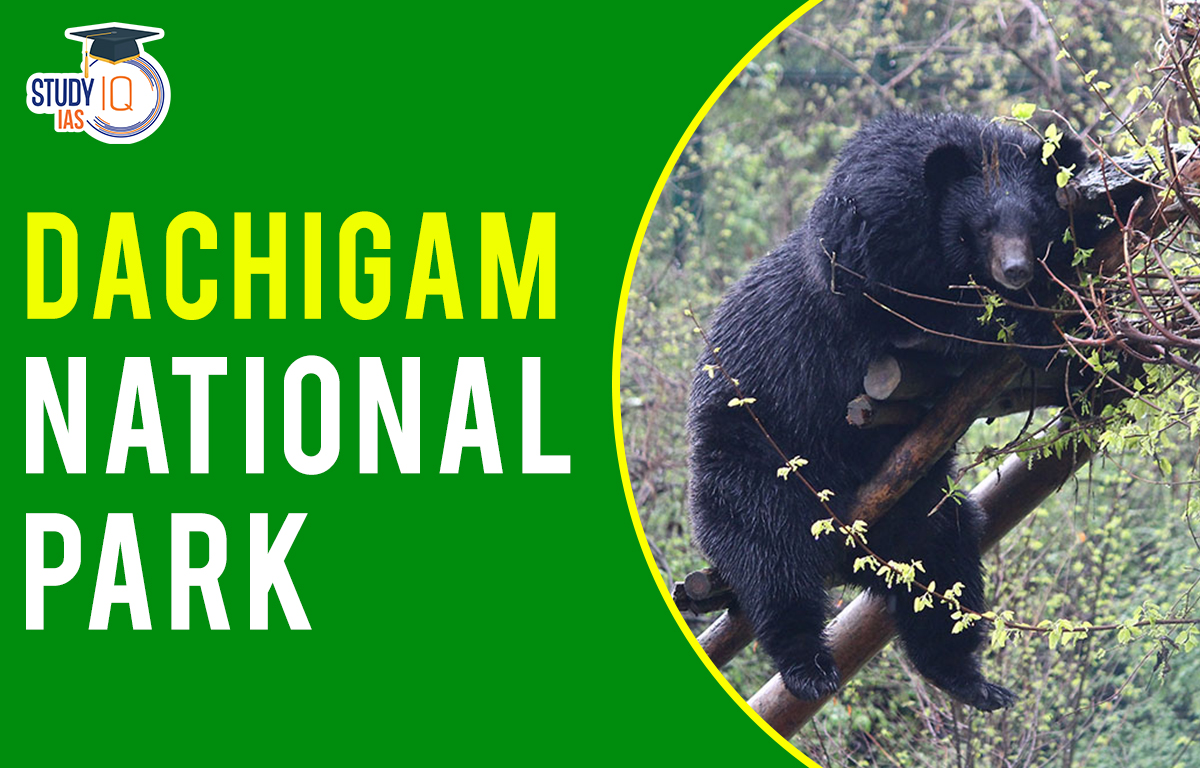Table of Contents
Dachigam National Park
Only 22 km from Srinagar, Dachigam National Park was created in 1981 and is situated in Jammu and Kashmir’s high-altitude subtropical zone. The forest rises 2990 metres above sea level on average. The area spans 141 kilometres. The main trees in the forest are deodar, pine, oak, and Himalayan moist temperate evergreen, moist deciduous, and shrubs. Dachigam means “ten villages” in Arabic. The UPSC Syllabus includes Nagarhole National Park and all national parks as significant topics of Environment subject. The UPSC Mock Test can help candidates prepare for the exam with more precision.
Dachigam National Park History
The park once solely served as the Maharaja of Kashmir’s private hunting preserve. Since 1910, the park has been a designated protected area; at first, it was governed by the Maharaja of Jammu and Kashmir, and then by the relevant government departments. Dachigam was initially established to ensure that the metropolis of Srinagar would have access to potable water.
The management of Dachigam was delegated to the State Government of Jammu and Kashmir after Jammu and Kashmir joined India. Throughout its existence, the State Fisheries Department, the Tawaza Entertainment Department, and the Forest Department have all played different roles in the Dachigam administration. It was declared a wildlife refuge by the government in 1951.
The Forest Department’s Directorate of Game Preservation has been in charge of it since 1978. The Directorate became an independent agency in 1982, and today it is known as the Agency of Wildlife Protection. In 1981, the Dachigam Wildlife Sanctuary received formal recognition as a national park. The total park covers about 141 km2. The name Dachigam, which translates to “ten villages,” was likely selected in honour of the ten villages that were relocated outside of the park and gave the area its current name.’
Dachigam National Park Feature
About 22 kilometres away from the Srinagar District, in the state of Jammu and Kashmir, is the Dachigam National Park, a breathtaking spot. The park once solely served as the Maharaja of Kashmir’s private hunting preserve. The initial goal of Dachigam was to make sure that the city of Srinagar would always have access to clean water. The Park is divided into Upper Dachigam and Lower Dachigam, two separate areas. Both regions differ greatly from one another in terms of terrain, flora, and fauna.
The rare and diverse bird and animal species that can be found in the area are well-known. The last genetically viable community of Hangul in the world resides in the park. The white patch on its rump and the magnificent spread of its antlers serve to identify this breed, which is closely linked to the red deer that reside in Europe. Among the creatures that live here are leopards, common palm civets, jackals, red foxes, muskrats, black bears, brown bears, yellow-throated martens, and Himalayan weasels. Over 145 various species of birds, including the Lammergeier and colourful ones like the Monal Pheasant and the Blue Magpie, can be seen.
Also Read: Periyar National Park
Dachigam National Park Flora
Lower than the tree line, the mountain sides are covered in forest. The vast bulk of the vegetation in this coniferous forest has broad leaves. In between, them are alpine pastures, meadows, waterfalls, and scrub vegetation. Deep gullies that flow down the mountain face are referred to as Nars in the local tongue.
The overwhelming majority of the grasslands and meadows are covered in a rainbow of vibrant flowers even during the harshest winters. Its interior contains Marsar Lake, which is located high up and serves as the Dagwan River’s source. This river flows past the bottom portion of the park and down to it. There, it travels along the only legitimate route in the park and is well-known for the abundance of trout that inhabit its waters.
Dachigam National Park Fauna
The most well-known mammal in Dachigam is the hangul, also referred to as the Kashmir stag. A few examples of other species include the Himalayan black bear, Himalayan brown bear, Kashmir grey langur, and Kashmir stag (hangul), in addition to the Musk deer.
Dachigam National Park UPSC
The Hangul population in Dachigam National Park is well-known throughout the world, and the park must be maintained to protect this seriously endangered species. Additionally, the park is home to a magnificent and unique natural ecosystem, which visitors from all over the globe are welcome to enjoy. The initial goal of Dachigam was to make sure that the city of Srinagar would always have access to clean water. It has been a protected territory since 1910, and in 1981 it was made a national park. Students can read all the details related to UPSC by visiting the official website of StudyIQ UPSC Online Coaching.


 Goods and Services Tax (GST), Objectives...
Goods and Services Tax (GST), Objectives...
 World Oceans Day 2025, History, Theme, S...
World Oceans Day 2025, History, Theme, S...
 World Environment Day 2025, Theme, Histo...
World Environment Day 2025, Theme, Histo...





















